
17 minute read
REEF CHECK
2019 INTERNATIONAL COASTAL CLEAN-UP HAILED A GREAT SUCCESS BY REEF CHECK MALAYSIA
On September 21st, Reef Check Malaysia, Yinson Holdings Berhad and Trash Hero Malaysia, along with other partners joined forces with thousands of people across Malaysia to participate in a nationwide cleanup effort. This was done in conjunction with the 33rd International Coastal Cleanup (ICC) Day 2019, as well as World Cleanup Day (WCD), which fell on the same day this year.
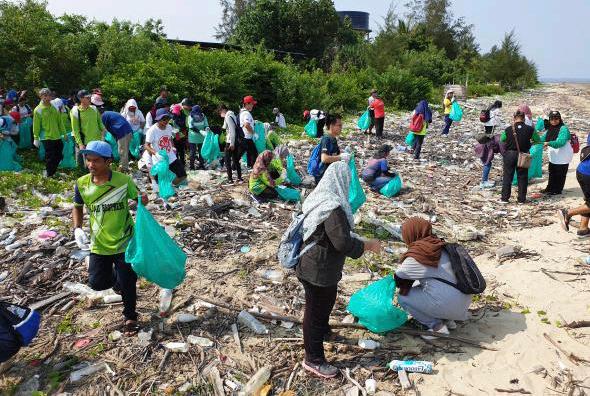
Photo by Go Green Club
The ICC is the world’s biggest annual volunteer effort to protect the oceans. Every year, millions of people around the world gather to collect trash along beaches and record information on the types of trash they collect, which provides insights into ways to tackle the ever-growing problem of marine debris.
In previous years, Reef Check Malaysia (RCM) has conducted clean-ups and educational programmes in conjunction with the ICC on Tioman and Mantanani Islands, but on a much smaller scale. In 2018, RCM organised the first large scale clean-up, which attracted nearly 5,000 volunteers across all states in Malaysia. RCM’s Theresa Ng, who coordinated the event, commented: “This year, expected turn-out was even higher than last year, with clean-ups planned in all 13 states plus Labuan Federal Territory. Some locations postponed their events into October due to the haze, so we will have final figures towards the end of October. But this year, 11,900 people participated, so that’s already more than last year.” According to Faisal Abdur Rani, leader of Trash Hero Kuala Lumpur, most locations had too much trash, which made it difficult for the volunteers to gather and record data.

Photo by Edmund Lau, RCM
Staff from our social media partner for this year, Coca-Cola, were also actively involved in the beach clean-ups. “We are glad to be partnering with RCM again for this year’s ICC programme. Apart from running beach clean-up events with our associates and partners nationwide, we run social media campaigns with Reef Check Malaysia to invite more Malaysians to be part of this event. Our efforts are in line with our World Without Waste vision, which is to collect and recycle a bottle or can for every one sold by 2030,” said Khairul Anwar Bin Ab. Gahani, Head of Public Affairs, Communications & Sustainability, Coca-Cola Malaysia.
These beach clean-ups are part of RCM’s long term campaign to reduce marine debris, specifically plastic waste. Ng added, “We are currently part of a multi-stakeholder group that is working to develop a Malaysian Plastics Pact (led by MESTECC) to reduce plastic waste in our landfills and environment. As part of that, we are conducting a recycling pilot project in a neighborhood in Kuala Lumpur to better understand why households are not segregating recyclables from general waste – in accordance with Act 672.We want to find mechanisms to incentivise households to segregate waste so that it can be available for recycling – rather than being dumped into landfills and then escaping into the environment.”

Photo by Coca-Cola
The clean-up was conducted at more than 100 locations around Malaysia. Almost 37,000kg of trash were removed from beaches, with the most common items being plastic beverage bottles, food wrappers and cigarette butts. Plastic grocery bags were also listed in the top five most common items found, besides plastic bottle caps. Some organisers have not recorded the number of individual items, as some locations had a lot of trash and it was very difficult to count them. These volunteers had to shovel the trash along the beach into bags instead of picking them up one by one. They reported a net close to 200kg and more than 1,500 polystyrene chips. The amount of trash collected in this location filled a 3-ton skip.
Julian Hyde, General Manager of RCM, added, “It is rewarding to see this event attracting even more people this year than last. Marine debris has widespread impacts on life in the ocean, and much of it is plastic and other trash that we discard without thinking. We would like to thank our sponsors and the thousands of volunteers who participated in the event this year; let’s make next year bigger again, raise awareness about the problem to a new level, and make sure that the government takes note – and takes action.”
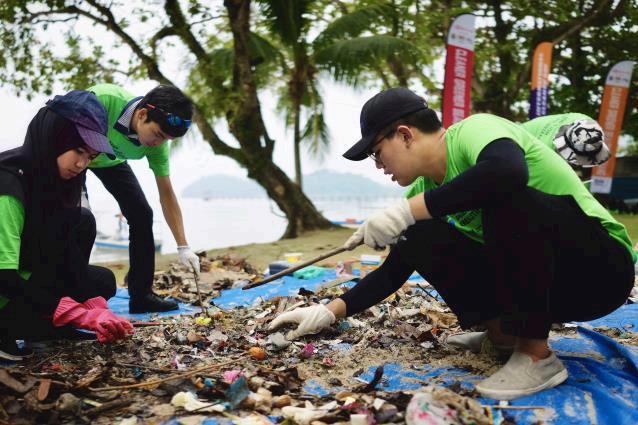
Photo by Javier Deng
WHAT A DIFFERENCE AN MPA MAKES! A SUMMARY OF THE 2019 CHANNEL ISLANDS ECOEXPEDITION BY SELENA MCMILLAN, SOUTHERN CALIFORNIA REGIONAL MANAGER, REEF CHECK CALIFORNIA
This year, twenty Reef Check Volunteers joined the Channel Islands EcoExpedition to survey several sites along California’s Northern Channel Islands. We successfully completed six sites at Anacapa and Santa Cruz Islands in two days. Due to high winds and big surf, we were not able to make it to our most remote sites at Santa Rosa Island, but instead managed to get in one day of fun diving at some new places on the back side of Santa Cruz Island.

Photo by Selena McMillan

Photo by Susy Horowitz
On the evening of August 4th , everyone boarded the dive charter, the Peace, to sleep through the crossing to Santa Cruz Island. The ride was rather bumpy as the weather had turned, and high winds were creating a large rolling swell. We woke up early the morning of the 5th and after breakfast, coffee, and a thorough briefing of Reef Check protocols and dive plans, we hopped in the water and surveyed our first site, CuevaValdez.This reef is outside of a Marine Protected Area (MPA) and was devoid of kelp, covered in urchins and mussel shells, but did have a few large sheepshead on the deeper transects. We then heard from Captain Steven that the weather report had changed for the worse, and we should change course to try to survey our sites on Santa Rosa Island. After thirty minutes of pounding the boat against the swell, we had to turn around and return to Santa Cruz, knowing that Santa Rosa was probably not going to happen on this trip.
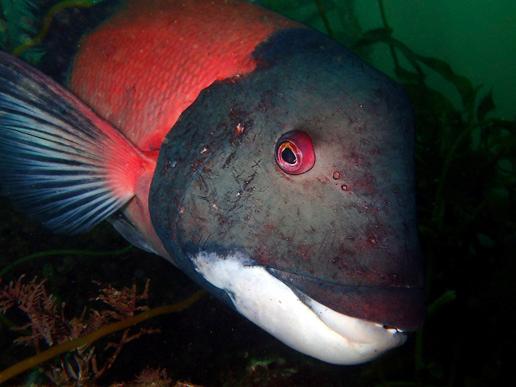
Photo by Susy Horowitz
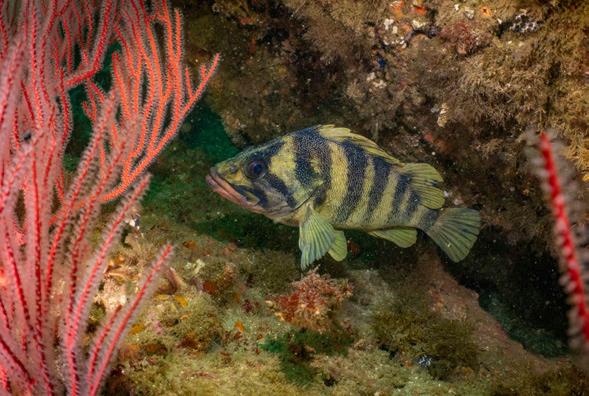
Photo by Mike Chiado

Photo by Mike Chiado
We completed our second survey at Fry's Anchorage. This site is also not located in an MPA and was similar to Cueva Valdez with very little kelp, but some more variety of inver tebrates and fish to count. When we surfaced and found the weather had gotten worse, we hurried back to the boat to move on to the next site, hoping that it was more sheltered from the increasing winds and strong currents.
Ourfinal site ofthe day,PelicanAnchorage,was an oasis compared to Fry’s Anchorage. It was calm, sheltered from the winds, and had more kelp to count. We decided to anchor there for the night and had a wonderful meal of prime rib, halibut and a lovely veggie roast. Some folks did a night dive, while many of us stayed on board watching the bioluminescence, pelagic red crabs, and flying fish feeding and flying around the boat.
The next morning, we completed our sites on Santa Cruz Island by surveying Scorpion Anchorage which is located inside a State Marine Reserve (SMR).This area is filled with pinnacles and shallow reefs. All of those who had nothing to do during kelp surveys the day before, were now busy counting Giant Kelp, Pterygophora, Laminaria, and Southern Sea Palm. We saw tons of invertebrates and lots of fish.
Many of our volunteers commented on the huge difference they observed between the three sites we surveyed the day before that were outside of MPAs compared to this site in an MPA.What a difference an MPA makes!
We then moved to Anacapa Island to complete our last two sites of our survey trip. Goldfish Bowl and Cathedral Cove are both in MPAs and are favourites amongst our volunteers. Both sites have healthy kelp forests and we saw lots oflarge fish and many species of invertebrates including Pink and Green Abalone. Once those sites were surveyed, we motored around the east side of Anacapa and got a good look at the lighthouse and beautiful arches there. We then went to the backside of Santa Cruz for the night, with the hope of doing a couple of fun dives the next day.
On our final day of the trip, we were able to dive at Gull Island before the winds picked up. This dive was amazing! We found a mixture of Southern and Northern California species, purple hydrocoral, large schools of Sheepshead,many species ofrockfish,colonial corals, tons of invertebrates, and a huge stand of giant kelp. We then went to Flame Reef, where we saw lots of brittle stars, keyhole limpets and several species of nudibranchs. A great day of fun diving for everyone on board. We made our way back to the dock in Ventura, getting home early but satisfied after a wonderful trip on board the Peace. Despite not being able to dive Santa Rosa Island, our trip was extremely successful. We are all looking forward to the Channel Islands Expedition 2020!
MY REEF CHECK EXPERIENCE: DIVING DEEPER INTO CORAL REEF WONDERS BY CECILIA VAROTTI, REEF CHECK ECODIVER
As a marine biology student, I’ve spent the past two years studying organisms living in the sea and the many threats they are presently facing. Reef ecosystems rapidly became my favourite topic. I hope to spend many years learning as much as possible about them.

I was extremely excited at the idea of taking part in a Reef Check EcoExpedition in Nosy Be, a tiny island nestled between Madagascar and Mozambique: it was going to be my very first experience on a tropical reef and it was going to be amazing.
What I certainly didn’t expect was my dominant feeling during our first dive in the Indian Ocean: confusion! Too many colours. Too many animals. Hard corals, soft corals; small fish, large fish; bright purple sponges, stinging hydrozoans; giant clams. It was all beautiful! But despite all my exams and all the studying, I couldn’t get my head around all those things: I finally saw with my own eyes what a diversity hotspot looks like. For a brief moment, I had the temptation to shut out all the questions, to stop thinking and just enjoy the reef for its aesthetic value (which was high anyway); but luckily for me (and my future career, one might say) I wasn’t there alone.

Thanks to our Reef Check guide, my professors and the staff of the Manta Diving Center of Nosy Be, dive by dive, my colleagues and I began to puzzle the reef out; we applied the Reef Check protocol, starting to recognise some key species and to interpret the meaning of the collected data. We also tried to identify some coral species using the Coral Finder, and eventually we were able to name some of them at first sight –which is not that easy! It might sound trivial, but it’s very satisfying and each new piece of information and knowledge makes you want to discover more. You become a better underwater observer and you appreciate all the interactions and peculiarities that a reef can offer.
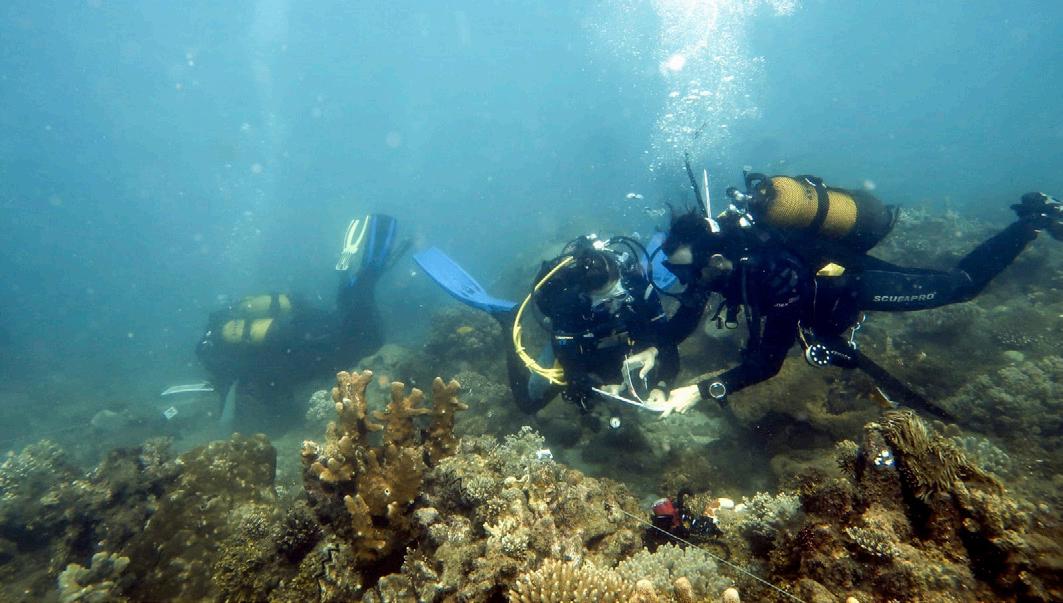
Even for non-marine biologists, I think Reef Check can be a first step towards a wider and more exciting diving experience; why stop at the surface? There is always a new question to be answered, a new reef to be discovered and explored.
In addition to improving my knowledge on coral reefs, the experience also brought new people into my life, people that share my passion for marine life and care about its conservation, and who made this journey fun; I’ve added several diving buddies to my contacts.
If you have doubts about the scientific merits of the data collected via the Reef Check protocol, I assure you that these records really have meaning and utility. They’re used in many research projects, for example I will use them to write my thesis. With the Reef Check protocol, you really get a chance to be involved in scientific research on coral reefs,often aiming at their conservation. Isn’t it exciting?
MY REEF CHECK JOURNEY: FROM THE MEDITERRANEAN SEA TO THE GREAT BARRIER REEF BY SUSANNA PRIMAVESI PHOTOS GEMMA MOLINARO
As an enthusiastic Italian scientific diver, I have been part of the amazing Reef Check family since 2018. My passion for the tropical environment and conservation have taken me to Australia to study the Great Barrier Reef. I took part in several projects, both in Italy and Australia, and found the methodologies are different based on vastly different marine habitats.

Reef Check Italy (RCI) has developed a set of protocols for monitoring the Mediterranean Sea, such as MAC (Coastal Environment Monitoring), Signal fishing nets, Temperature relief, Signal nudibranchs, gorgonians and mass mortality reports. Italy is important for Mediterranean biodiversity; however, this fragile ecosystem is at risk due to human activity and climate change effects such as rising water temperatures and the presence of invasive species.
As Reef Check Italy EcoDiver volunteers, we monitor coastal environments recording the presence and absence of indicator species. The methodology of MAC is based on a visual census in random paths, called ‘’timed swims’’. Reef Check Australia (RCA) has different protocols, but like RCI, the goal is monitoring and data collection to help manage their underwater habitats. The RCA method is conducted along a transect line where surveyors collect information about substrate, density of inver tebrates and fish, and impacts on the reef.
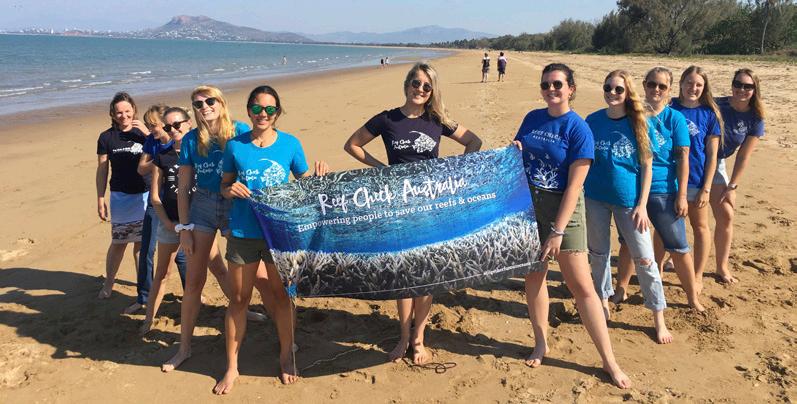
In recent years, the Great Barrier Reef has been subject to climate change and human impacts, such as mass bleaching events, cyclone impacts and Crown of Thorns Seastar outbreaks which have led to coral loss and mortality in some areas.
During September, I participated in RCA’s Reef Check Ambassador Training to learn how to educate people about the ocean and empower them to be reef-friendly. One week later, I and other citizen scientists attended a Reef Leadership workshop organised by RCA and Reef Ecologic at the Orpheus Island Research Station. In this workshop, we learned about three different monitoring methods used to gain knowledge about the health of reefs through Coral Watch, RHIS (Great Barrier Reef Marine Park Authority’s Citizen Science monitoring method) and Reef Check Australia. We collected RCA survey data at Magnetic Island sites, which are nearshore fringing coral reefs. We found a high presence of macroalgae, diverse coral communities and low visibility due to the proximity to shore.

In contrast to Magnetic Island, John Brewer Reef, an outer reef, had higher coral cover, less macroalgae and amazing visibility. With Reef Ecologic staff we did two surveys with both RHIS and RCA methods. Our next outer reef was Lodestone Reef. We did two surveys and sadly, we saw large areas of coral mortality due to Crown of Thorns and bleaching. Just two years ago, there was a high diversity of coral at this site.
Visiting these two outer reefs and the fringing Magnetic Island reefs, a stark contrast is evident between inshore and offshore reefs. The outer reef is more coral dominated, while the inner reef is algae dominated; however, Crown of Thorns impacts have also transformed sites at outer Lodestone Reef by significantly reducing coral cover. Days later, we participated in a clean-up event as a Reef Check Ambassador, organised by Tangaroa Blue. We collected marine debris from two beaches on Hinchinbrook Island and found just under 2 tons of debris!
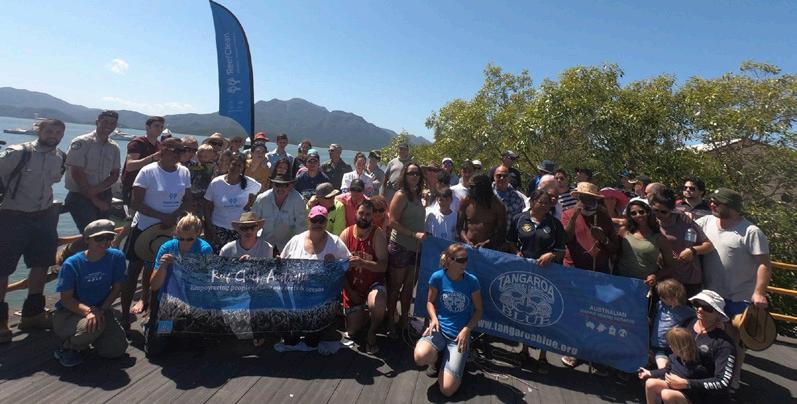
One week later, with RCA, I participated in a Reef Clean project at Hook Island. We collected and sorted debris from beach and underwater clean-ups, allowing us to see what is washing up on the beach instead of sinking to the ocean floor. We found mostly debris dropped by tourists. We also did RCA surveys on local fringing reef sites.
Although the Mediterranean Sea and the Great Barrier Reef are two very different ecosystems, with different impacts and threats, Reef Check Worldwide has the same driven and dedicated volunteers helping to collect data and protect the natural environment, empowering people to take care of the ocean so we can have a better future outlook.
NATURE FIGHTING BACK: MALDIVES REEFS SHOWING RESILIENCE BY BIOSPHERE EXPEDITIONS
Biosphere Expeditions, the Marine Conservation Society, Reef Check Maldives and local Maldives environmental group, Save the Beach Maldives have just returned from a 250km expedition around the central Maldives, the ninth annual survey of its kind since 2010. They found, against expectations, that corals are showing some resilience, adaptability and even recovery from climate change effects.

Reefs the world over are dying from rising sea temperatures, ocean acidification, pollution and overexploitation. The situation is much the same in the Maldives, as previous Biosphere Expeditions surveys and averyrecentscientific paper have shown.
Expedition scientist (and co-author of the recent paper) Dr. Jean-Luc Solandt, this year expected more dead and dying reefs. But what he and his team of citizen scientists found instead, are signs of hope and recovery. Dr. Solandt said, “We were devastated in 2016 when a global warming event killed off large swathes of the reefs. The reefs showed little recovery in 2017 and 2018, and we expected more bad news in 2019. However, this year we saw many baby (<1 year) and young corals (1-3 years), as well as different species of corals growing vigorously at sites that we expected to be dead or dying. It was surprising and encouraging to see a greater diversity of corals ‘pushing through’ from the dead layer below. It seems nature is fighting back with a coral diversity explosion. We have seen resilience (of corals that are resistant to bleaching), adaptability (some reefs have other species coming through) and recovery (baby corals are almost everywhere) this year”, concludes Solandt.
“It’s not all plain sailing though,” adds Solandt, “many reefs are still very badly affected and some have died altogether. And another temperature spike would kill many of the new corals we’ve seen. Also, some small corals that had settled on the reef in the last year, which we thought were resistant to bleaching, were now bleached, but the larger ones seem okay. Finally, the background temperature is still ‘hot’ at the bleaching threshold of 30 degrees Celsius in very shallow water.”
The recent change in government in the Maldives is another cause for some optimism. Hussein Zahir, head of LaMer, one of the expedition’s local partner organisations, notes that the government has indicated that it “understands the close link between oceans, climate change and the wellbeing of communities. This is a good start, as is the establishment of a National Research Institute that includes environment, health and social issues – a sort of think-tank and an infrastructure for science-based knowledge and understanding of the issue. And apparently the income from the Green Tax that has been levied on the tourism sector will now be spent exclusively on the environment”.
One of the outstanding sites regularly visited by the annual Biosphere Expeditions surveys called ‘Rasdhoo Madivaru’, has also recently been declared a Marine Protected Area. It is both resilient to the worst bleaching effects, and harbors large megafauna such as sharks, manta rays, turtles and Napoleon wrasse. “Our expeditions have highlighted this site for the past nine years as being of extraordinary biodiversity value”, says Solandt.
Dr. Matthias Hammer, Executive Director of Biosphere Expeditions believes that “all those involved in the last nine years of expeditions – from professional to citizen scientists, to local and international partners – can be very proud about the in-depth understanding and description of bleaching patterns we have reached and that we have been involved in the designation of an MPA. This is yet another feather in our cap of achievements through citizen science and community-based conservation, and an important stepping stone for tackling the adverse effects of climate change in the Maldives. It shows how ordinary people and grassroot actions can make a difference”.
Further surveys will be carried out by Save the Beach Maldives and Reef Check Maldives. These local organisations, the latter created by graduates of the Biosphere Expeditions placement programme, will “also train more local divers to survey their own reefs in the future, and set up more community-based reef conservation efforts”, according to Hassan ‘Beybe’ Ahmed, a placement programme graduate who runs Save the Beach Maldives and Reef Check Maldives. The Biosphere Expeditions annual survey will return to the Maldives in August next year.










